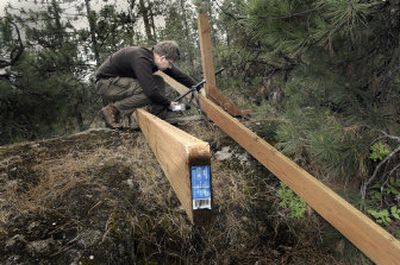Toward a more attractive, usable Beacon Hill for bikers

Rising gas prices and the recent Bike to Work week have caused many residents to dust off their bicycles and reacquaint themselves with pedal power. However, for some folks bikes are more than just a method of transportation – they are a way to combine great exercise with a love of the outdoors.
Penny Schwyn, president of the Fat Tire Trail Riders Club, said, “My husband bought me my first mountain bike 10 years ago.” She hasn’t looked back. She and other bike enthusiasts say Spokane and Coeur d’Alene residents have much to be thankful for.
The area has a wide variety of scenic bike trails. From Mount Spokane to the Lost Creek Trail on the north fork of the Coeur d’Alene River, there are destinations for every biker’s ability.
One of the most popular destinations is Beacon Hill, the area encompassing the ridgeline north of the Spokane River and east of Market Street. The Fat Tire Club focuses time and effort on improving the Beacon Hill bike trails. The 45-member group has corrected an erosion problem and picked up trash, in addition to building a new trail last year. “We’re out there for the love of the trail – the love of the ride,” Schwyn said.
The club is also working with the City Parks Department developing the Camp Sekani Bike Park, located in the Beacon Hill area. “A bike park is like a skateboard park for mountain bikers,” she said.
Mike Aho manages the 240-acre Camp Sekani park for the city of Spokane. He said the bike park will eventually have three components. The first is a skills park area, which he described as “a bunny hill for downhill mountain bikers.” The second, a free-ride portion, offers more challenging courses, like a dual slalom hill and dirt jumps. Cross-country trails will make up the third feature of the park.
According to Schwyn, the area is popular with mountain bike riders because of its beautiful natural terrain and its accessibility. Users can enter the trails at several points, including Esmeralda Golf Course, Minnehaha Climbing Rocks and Boulder Beach on Upriver Drive.
The Fat Tire Club has adopted Camp Sekani through the city’s adopt-a-park program. The city and the club share a common goal. They want to make the area attractive and usable for everyone – not just mountain bikers. To that end the club is sponsoring a two-day Beacon Hill Trail Connections Charrette in October. A charrette is a fancy word for a design workshop.
For the workshop, the Fat Tire Trail Riders Club is teaming up with the Parks and Recreation Department, Spokane County, the National Park Service, the American Society of Landscape Architects, International Mountain Biking Association, Minnehaha Neighborhood Council, and other organizations, as well as residents and area businesses. They hope to implement ways to make better connections between this unique trail system and the Spokane community.
“The whole trail system should be accessible to family bikers, hikers and bird watchers,” said Schwyn. “The basic idea of the design workshop is to reach out into the community and gather input from all different groups of people.” She said that only 40 percent of the Beacon Hill area is public land. The rest belongs to Avista, private landowners and businesses.
Aho said, “I’d like to see all interested users participate.” He pointed out that Spokane’s two largest city parks, Riverfront and Camp Sekani, are connected by the Centennial Trail. “We have the ability to become a regional feature,” he said.
But most of all, Aho and Schwyn want residents to understand and appreciate the natural wonder and resources contained in the Beacon Hill area.
Those who view bike riding as something they outgrew long ago might want to explore it again. Schwyn explained the attraction this way: “I feel like a kid when I’m on my mountain bike. It gives me a lot of joy and it’s cheaper than therapy.”